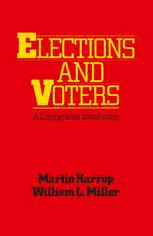
Elections and Voters: A comparative introduction PDF
Preview Elections and Voters: A comparative introduction
Elections and Voters Also by Martin Harrop Comparative Government:An Introduction (with Rod Hague) Also by William L. Miller Electoral Dynamics The End ofBritish Politics? The Survey Method Elections and Voters A comparative introduction Martin Harrop and William L. Miller ~ MACMILlAN © Martin Harrop and William L. Miller 1987 All rights reserved. No reproduction, copy or transmission of this publication may be made without written permission. No paragraph of this publication may be reproduced, copied or transmitted save with written permission or in accordance with the provisions of the Copyright, Designs and Patents Act 1988, or under the terms of any licence permitting limited copying issued by the Copyright Licensing Agency, 90 Tottenham Court Road, London W1P 9HE. Any person who does any unauthorised act in relation to this publication may be liable to criminal prosecution and civil claims for damages. First published 1987 by THE MACMILLAN PRESS LTD Houndmills, Basingstoke, Hampshire RG21 2XS and London Companies and representatives throughout the world ISBN 978-0-333-34760-7 ISBN 978-1-349-18912-0 (eBook) DOI 10.1007/978-1-349-18912-0 A catalogue record for this book is available from the British Library. 11 10 9 8 7 6 5 03 02 01 00 99 Contents Preface IX 1 Introduction 1 Control and choice in elections 1 What do we mean by a competitive election? 2 Why study elections? 9 Further reading 10 PART I ELECTIONS: CONTROL VERSUS CHOICE 2 Political Control: Non-competitive Elections 15 Elections under communism 16 Acclamatory elections: the USSR 20 Candidate-choice elections: Poland 22 What do communist elections do? 24 Elections in the Third World 29 Dominant-party elections: Mexico 32 Candidate-choice elections: Kenya 33 Conclusion 36 Further reading 37 3 Political Choice: Competitive Electoral Systems 41 What is an electoral system? 41 What is required of an electoral system? 42 The scope and powers of elective office 43 Registration: an effective franchise 44 Translating votes into seats 45 The territorial dimension 52 v vi Contents The time dimension 55 Choosing candidates 57 Manipulating the system 60 Do electoral systems influence party systems? 63 Further reading 72 4 The Electoral Message: Interpreting Election Results 76 Introduction 76 How to classify competitive elections 78 Why expectations are crucial 84 How to misinterpret elections 86 Interpreting non-national elections 91 Conclusion 94 Further reading 95 PART II VOTERS: LOYALTY VERSUS CHOICE 5 HowVotersThink About Politics: Ideologies, Issues and Images 101 Do people think about politics? 101 Why do people think about politics? 102 Who thinks about politics? 103 When do people think about politics? 105 What political objects do people think about? 106 What kinds of thoughts do people have? 110 Do people use ideological concepts? 117 Do people have belief systems? 121 Conclusion 125 Further reading 125 6 Psychological, Economic and Sociological Models of Voting 130 The party identification model 131 The rational choice model 145 The sociological approach 157 Conclusion 161 Contents vii Further reading 162 Appendix: analysing the relationship between partisanship and issue attitudes 163 7 The Social Bases ofVoting Behaviour 173 Cleavage structures of the national revolution 175 Cleavage structures of the industrial revolution 182 The impact of the state 193 Post-industrial influences 198 Other influences 202 Conclusion 211 Further reading 212 8 The Responsive Voter: Short-Term Influenceson Voting Behaviour 217 The economy 217 The mass media 220 The politicians 225 The campaign 227 Canvassing 231 ~oney 233 Opinion polls 236 Conclusion 237 Further reading 237 CONCLUSION 9 What Do Elections Do? 244 Provide representation? 245 Offer a choice? 247 Make governments? 249 Influence policy? 251 Give mandates? 255 Add legitimacy? 258 Strengthen elites? 262 Educate voters? 265 Vlll Contents Influence parties? 267 Conclusion 268 Further reading 269 Index 273 Preface When Steven Kennedy of Macmillan suggested we write a text book on voting behaviour we readily agreed.There clearly was a need for such a book and we felt familiar enough with the literature. We thought it would not take very long to write. Several years and as many drafts later the manuscript is now complete, but it is no longer restricted to electoral behaviour. To understand voters,we had to understand elections.To understand competitiveelections, we had to understand non-competitiveelec tions.And so the book's scope expanded into its present form. To teachers, students (and publishers!) who would have preferred a shortertext restricted to the findingsofvoting surveys, wecanonly say that it makes more sense to look at both elections and voters together. As the book's range has extended, we have drawn more and more on the expertise of our colleagues. We would like to thank Hugh Berrington, Richard Crook,Rod Hague,Stephen White and John Wiseman for their help. We are also grateful to Macmillan's academic readersfor theirconstructive (ifoccasionally conflicting) advice. The errors and omissions remain our own. On one point we have not wavered. A textbook written for students must be comprehensible by students. We are grateful to undergraduates at Glasgow, Newcastle and Strathclyde Univer sities for ruthlessly expunging any unnecessary jargon from earlier drafts - and for persuading us that most of the jargon was unnecessary. Joint authorsoften indicate which author wrote whichchapters. We began by draftingouthalfa bookeach.But asthe text evolved we editedeach other's drafts with vigour, shiftedmaterialbetween chapters, and recast the structure of the book. A few single authored paragraphs may have survived,butwetake jointrespon sibility for all the chapters. MARTIN HARROP WILLIAM L.MILLER ix
